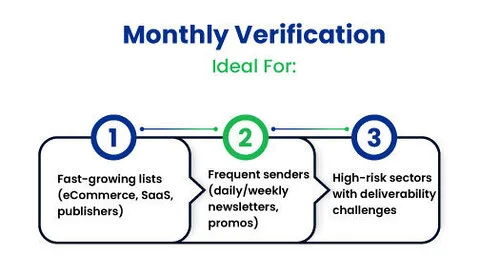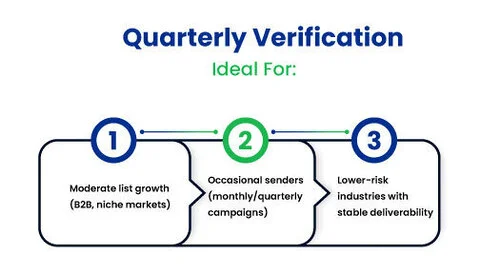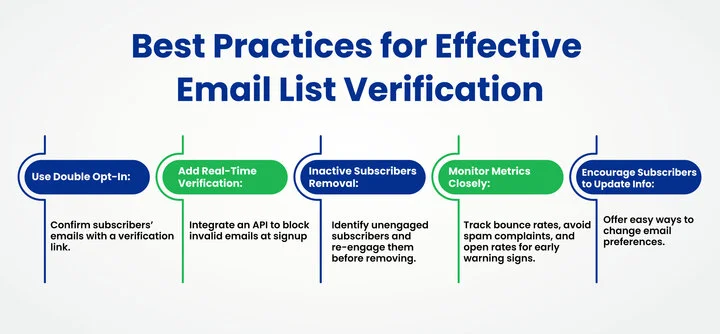Email marketing is one of the most powerful digital marketing channels, delivering a high ROI across various industries. According to Litmus, email marketing generates an average ROI of $36 for every $1 spent, making it one of the most cost-effective channels available.
However, the success of any email campaign depends heavily on the quality of your subscriber list. Sending emails to outdated, invalid, or inactive addresses can compromise email deliverability, increase bounce rates, and damage your reputation.
This highlights the importance of email list verification. But a common question marketers face is:
How often should you verify an email list?
Should you do it monthly or is quarterly enough?
In this blog, we will bring light to the importance of email list verification and understand the differences between monthly vs. quarterly email list cleaning to help you determine the right frequency for your business.
What Is Email List Verification?
Email list verification is the process of checking whether the addresses in your subscriber database are valid, active, and safe to send emails to. Popular email Verification tools analyze each address for issues such as:
- Invalid email addresses: Typos or non-existent domains.
- Disposable emails: Temporary addresses that expire quickly.
- Spam traps: Fake emails used by ISPs to catch spammers.
- Role-based emails: Addresses like info@ or support@ that don’t belong to a specific person.
- Inactive addresses: Emails that no longer engage with your content.
By filtering out these risky addresses, verification ensures your campaigns reach real people, increasing email deliverability and protecting your sender reputation.
How Email List Verification Impacts Your Marketing Success?
According to the business research insights report, the email list verification tools market is valued at USD 0.13 billion in 2024 and is projected to grow to USD 0.27 billion by 2033, reflecting the rising demand for cleaner, high-quality email lists.
The growth underscores the fact that the success of any email marketing campaign depends not just on compelling content but on the quality of your contact list, making email list verification a critical factor in driving real marketing results. Prioritizing email verification offers powerful benefits for your marketing strategy:
1. Better Deliverability
Email service providers (ESPs) monitor your bounce rate. A high bounce rate indicates poor practices, which can reduce inbox placement.
2. Protect Sender Reputation
Sending to invalid or spam-trap emails can get your domain flagged, harming your ability to reach customers. Email verification helps you reduce bounce rate and improve ROI by maximizing deliverability.
3. Accurate Analytics
A clean list provides more reliable open and click-through data, helping you make informed marketing decisions.
4. Cost Efficiency
Most email platforms charge by the number of contacts. Email list cleaning means you only pay for valid, active subscribers.
5. Improved Engagement
Verified lists ensure your campaigns reach people who actually want to hear from you.
In a nutshell, verifying your email list regularly is not just a best practice but essential for long-term success.
Monthly vs Quarterly Email Verification: Find the Right Frequency
Both monthly and quarterly email verification have their pros and cons. The right email list cleaning schedule depends on your list growth, industry, and campaign frequency.
The Right Time for Monthly Verification

The advantages and disadvantages of monthly verification include:
| Pros | Cons |
|---|---|
| Keeps your list extremely fresh. | It can be costly if you’re verifying a large list every month. |
| Reduces the risk of spam traps and high bounce rates. | It may be unnecessary for smaller businesses with slower list growth. |
| Supports high-frequency senders who need excellent deliverability. | |
| Provides more accurate performance metrics. |
The Right Time for Quarterly Verification

The benefits and drawbacks of quarterly verification are:
| Pros | Cons |
|---|---|
| More cost-effective compared to monthly checks. | Lists may accumulate more inactive or invalid emails between verification cycles. |
| Still ensures lists are kept relatively clean. | Riskier for businesses sending high-volume or frequent campaigns. |
| Works well for businesses with predictable campaign schedules. | |
How to Choose Between Monthly and Quarterly Verification?
Deciding between monthly and quarterly email list verification depends on how fast your list grows, how often you send campaigns, and the level of risk in your industry.
Let’s look at the key considerations:
| Factor | Monthly Verification | Quarterly Verification |
|---|---|---|
| List Growth Rate | Best if adding hundreds or thousands of new subscribers each month. | Suitable if list growth is slow (a few dozen signups monthly). |
| Sending Frequency | Ideal for daily or weekly campaigns to minimize risk. | Works for monthly or seasonal campaigns. |
| Industry & Audience | Needed for industries with high churn (retail, SaaS, publishing). | Fine for B2B companies with stable, niche audiences. |
| Deliverability Goals | Ensures 98–99% deliverability for large-scale campaigns. | Acceptable if deliverability and engagement are already stable. |
| Budget | It can be costly but worth it for frequent senders. | More cost-effective for smaller businesses; can use real-time verification at signup. |
Tired of Emails Ending Up in Spam? Keep your email list verified to boost deliverability and ensure every message reaches the inbox.
The Risks of Not Verifying Your Email List Regularly
The global email verification market is worth about USD 620 million in 2024 and is expected to more than double, reaching USD 1.44 billion by 2033, growing at around 10.2% each year.
This rapid growth highlights how essential verification has become, because failing to verify your email list regularly can damage deliverability, increase bounce rates, and ultimately weaken the impact of your marketing campaigns.
If you delay list verification for too long, here’s what can happen:
- High Bounce Rates: Even a 2% hard bounce rate can hurt your reputation.
- Spam Complaints: Outdated addresses increase the risk of hitting spam traps.
- Lower Engagement: Sending to unengaged subscribers drags down open and click rates.
- ESPs Blocking Campaigns: Gmail, Outlook, and Yahoo may start sending your emails straight to spam.
- Wasted Budget: You end up paying for contacts who will never engage.
In other words, inconsistent verification isn’t just risky but also directly costs money and reputation.
How Do Businesses Apply Monthly vs. Quarterly Email List Verification?
Different industries manage email list verification in unique ways. To better understand how often clean email lists are utilized, let’s examine how different types of businesses approach this issue.
1. eCommerce
For an online store sending multiple promotional emails every week and collecting thousands of new leads each month, deliverability and engagement are absolutely critical. These businesses operate in highly competitive markets where even a slight drop in open or click-through rates can lead to significant revenue loss.
The best approach is monthly verification combined with real-time signup checks. This ensures that invalid or disposable emails are filtered out quickly, keeping the list accurate and maximizing conversions during limited-time promotions and flash sales.
2. SaaS
A SaaS company adding 300–500 leads per month typically runs a mix of onboarding campaigns, product updates, and monthly newsletters. Since the list is growing steadily but not at a high velocity, quarterly verification, along with real-time validation at signup, is usually sufficient.
This balance keeps the list clean without incurring unnecessary costs. It also helps maintain strong email deliverability, which is essential for customer retention and upsell campaigns in the SaaS space.
3. Niche B2B Consulting Firm
Consulting firms often build their contact lists through referrals, networking, and industry-specific events rather than mass lead generation. They tend to send fewer campaigns, such as quarterly reports or event invitations.
In this case, quarterly or even bi-annual verification may be enough. The slower pace of list growth reduces the risk of invalid contacts, and maintaining a professional sender reputation is more important than high-frequency verification.
This approach allows such firms to focus resources on personalization and high-value client communications.
Best Practices for Effective Email List Verification
Choosing monthly or quarterly verification is only part of the equation; following email marketing best practices ensures your list stays accurate longer:

Frequently Asked Questions (FAQs)
What Is The Best Time To Verify An Email List?
The best time to verify your email list is before major campaigns or seasonal promotions. For example, ahead of Black Friday, product launches, or fundraising drives. Verifying just before big sends ensures maximum deliverability and improves sender reputation when engagement is most important. In addition, running verification after a large influx of new subscribers helps remove invalid or temporary signups immediately.
Should I Verify My Email List Monthly Or Quarterly?
It depends on your business model. If you’re collecting thousands of new leads every month and sending frequent campaigns, monthly verification ensures your list remains accurate and engagement stays high. However, if you’re a SaaS company or B2B business with slower list growth, quarterly verification may strike the right balance between cost and deliverability.
How To Decide Email List Verification Frequency?
You can determine the right frequency by evaluating four key factors:
- List Growth Rate
- Campaign Frequency
- Bounce Rate Trends
- Industry Type
Conclusion
Determining how often you should verify your email list often comes down to balancing consistency with cost.
So, how often should you verify an email list?
If you run high-frequency campaigns with rapid list growth, monthly verification is worth the investment.
However, if your campaigns are less frequent with steady but moderate growth, quarterly verification is generally sufficient. For maximum efficiency, combine real-time verification at signup with your preferred schedule.
Regular verification ensures your campaigns consistently reach the right audience. The good news is that you don’t have to compromise now. With the right email verification services, businesses can maintain a clean, reliable list without overspending.
At the end of the day, the email list verification improves sender reputation, maximizes deliverability, and gets the best ROI from your email marketing.
Stop Losing Leads to Invalid Emails. Build a verified outreach list to reduce bounces, increase engagement, and get better results from every campaign.
Leave a Reply